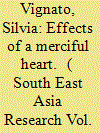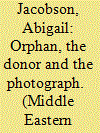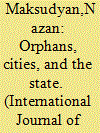|
|
|
Sort Order |
|
|
|
Items / Page
|
|
|
|
|
|
|
| Srl | Item |
| 1 |
ID:
158206


|
|
|
|
|
| Summary/Abstract |
In this article, I examine the relationship of charitable help that, through the persons and the work of caregivers, connects some donors to the young persons who grow up in home-based childcare institutions in contemporary Malaysia. The prism of my analysis is the small charity functions that take place within the homes that I have studied, which allow donors and receivers to elaborate, perfect and enact moral ideas of themselves and of their place in society. Because they stage the main characters of charity, the functions also give an insight into how, since an early age, children actively explore the dominant and largely ethnicized model of virtue and merit they are summoned to embody, thus making sense of their shared condition of “charity children”. This self-care work, I argue, inspired by Erica Bornstein’s study on Indian charity, is made possible by the “pure gift” core that characterizes donors and caretakers, as it frees the aided children from the necessity to “buy” their care back, which is otherwise requested in traditional child fostering.
|
|
|
|
|
|
|
|
|
|
|
|
|
|
|
|
| 2 |
ID:
183191


|
|
|
|
|
| Summary/Abstract |
This study examines a fairly classic phenomenon of urban and social transformations resulting from political changes: the Armenian ‘neighbourhood’ of Jerusalem. The Monastery of St James, seat of the Armenian Patriarchate of Jerusalem, was transformed after the First World War into a neighbourhood made up of a refugee population that survived the genocide of 1915. The activity of two orphanages set up around the Patriarchate illustrates these transformations.
|
|
|
|
|
|
|
|
|
|
|
|
|
|
|
|
| 3 |
ID:
177683


|
|
|
|
|
| Summary/Abstract |
This article uncovers the short history of the American Colony Christian Herald Orphanage, operating in Jerusalem following the First World War. Hosting around 36 Christian and Muslim girls, the orphanage relied on the financial support of the American-based Christian Herald newspaper. Through the close analysis of this institution, and the comparison with a Jewish orphanage in Jerusalem, the article will critically discuss the links between humanitarianism and photography. The sources used are an annotated photograph album documenting life in the Orphanage, as well as the Record Book documenting the girls who received support through the orphanage. Using these visual materials, the article addresses the ways photographs were used as part of fund-raising, missionary work and relief efforts in the context of Mandatory Jerusalem, and discusses the complex relationship between the orphan girl, the donor who supports her, and the way this relationship is constructed in the photograph.
|
|
|
|
|
|
|
|
|
|
|
|
|
|
|
|
| 4 |
ID:
106950


|
|
|
|
|
| Publication |
2011.
|
| Summary/Abstract |
This article examines the relationship between state and society in the Ottoman Empire during the 17th and 18th centuries by examining concepts and practices of privacy. Fatwas of Ottoman jurists reveal certain principles ordering the division of urban areas into public and private spaces. The article explores their application during the rebuilding of Damascus after its devastation by an earthquake in 1759. Archival sources disclose the priorities that guided the state in reconstructing a ruined provincial capital: religious values; a concern for the inhabitants' well-being; and, rather prominently, an intent to maintain a dichotomy between public and private. In this the Ottomans were different from their contemporary European counterparts, who often took advantage of major disasters to reshape relations between rulers and subjects. This divergence is demonstrated in this article by comparing post-1759 Damascus with London after the Great Fire of 1666 and Lisbon after the 1755 earthquake.
|
|
|
|
|
|
|
|
|
|
|
|
|
|
|
|
| 5 |
ID:
126698


|
|
|
|
|
| Publication |
2013.
|
| Summary/Abstract |
Critics of intercountry adoption define it as a demand-driven market for babies, from which parents in rich countries benefit at the expense of those in poor countries. Advocates hold that it often provides the best chance for orphaned children to grow up in a family. This paper investigates these opposing claims. It develops a theory that outlines the circumstances under which intercountry adoption is likely to result in a "baby trade," and evaluates expectations derived from that theory on the basis of data on adoptions to the United States. The findings suggest that sending countries with large and fast-growing adoption programs may be particularly vulnerable to the temptation to supply a demand-driven market. However, sending countries do not simply respond to international incentives. Instead, the variation in participation in intercountry adoption between sending countries is partially driven by domestic incentives. The paper ends with suggestions for future research and policy.
|
|
|
|
|
|
|
|
|
|
|
|
|
|
|
|
|
|
|
|
|